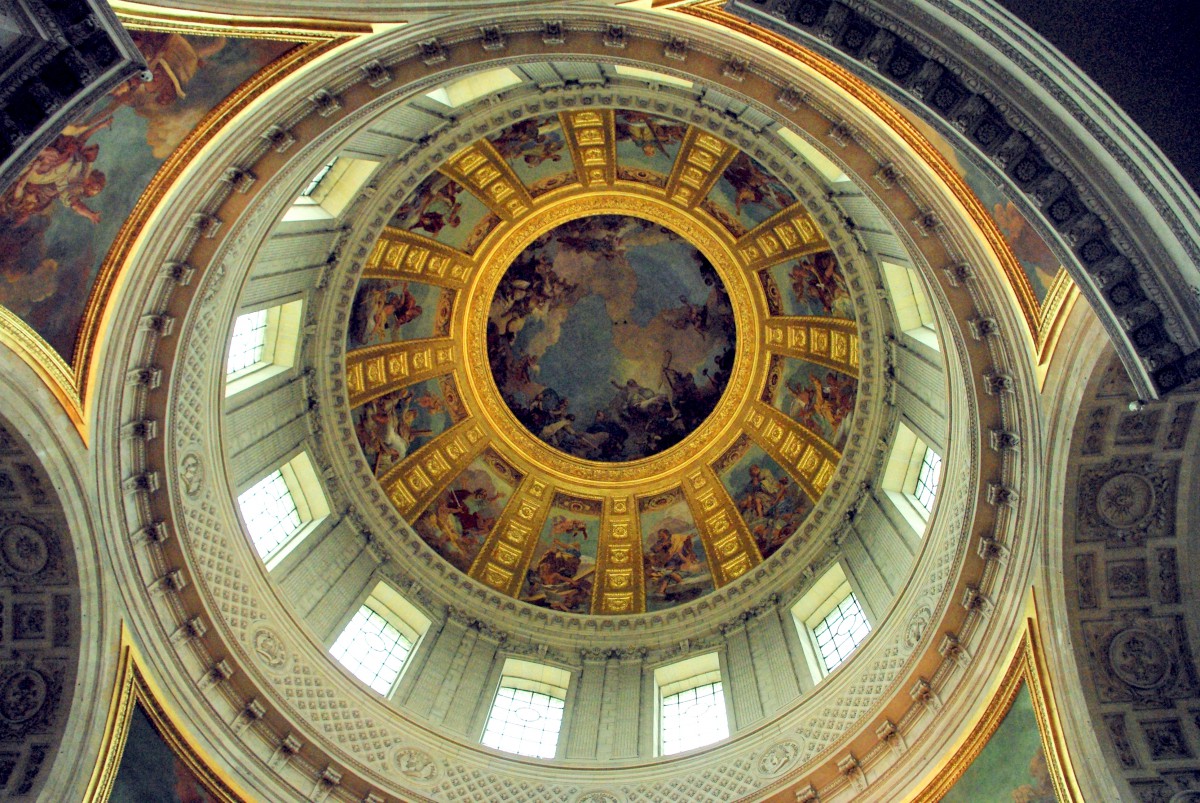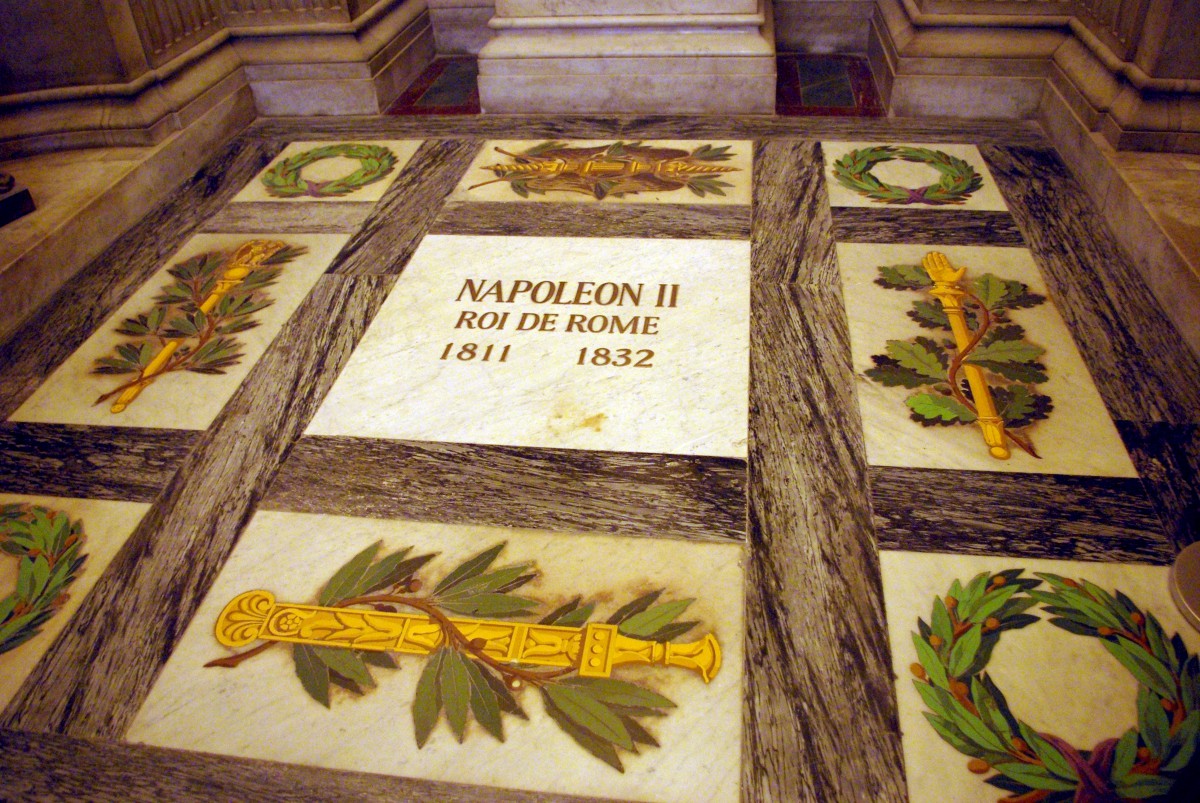The glittering golden roof of the Dome church is an unmissable landmark in the Parisian landscape. Situated in the 7th arrondissement of Paris, the monument is the symbol of the Hôtel des Invalides.
Since its edification commissioned by King Louis XIV in 1706, the sanctuary has been turned into a French military memorial.
Inside you’ll find the remains of some of France’s war heroes (De Lattre de Tassigny, Duroc, Foch, Lyautey, Turenne). But visitors come first and foremost to admire the monumental tomb of Napoleon Bonaparte which lies in the crypt.
I’ve been there twice and each time it seemed like I had a date with the history of France!
The Dome Church of Les Invalides

In 1676, King Louis XIV commissioned from Jules Hardouin-Mansart the construction of a place of worship in the centre of the complex of Les Invalides.
The project combined:
- a veterans’ chapel (now Cathedral of Saint-Louis des Invalides) and
- a chapel reserved for the exclusive use of the King (now the Dôme des Invalides).
The royal church was dedicated to Saint-Louis and is therefore often referred to as Eglise Saint-Louis des Invalides.
Works on the Dome church took 27 years to complete.
The church and its gilded dome

The monumental dome was inspired by St. Peter’s Basilica in Rome. It is one of the greatest examples of French Classical architecture. It dominates the court of honour and can be best admired from the Place Vauban.
The wide staircase (15 steps) leads to the majestic entrance of the Dome church.
The first level of the façade is ornate with Doric columns and two niches containing the statues of St. Louis and Charlemagne.

The second level consists of Corinthian columns. Four statues placed in front of the pilasters adorn it. They represent Justice, Temperance, Prudence and Strength.

A triangular pediment crowns the two first levels and features the coat of arms of the King of France (three fleurs-de-lys).

The top of the dome
The top of the dome is ornate with gilded garlands, helmets and trophies.



It ends with an elegant lantern adorned with the allegories of Faith, Hope and Charity.



A three-side obelisk topped with a cross marks the monument’s summit.
The tall dome was gilded for the first time in 1706. As a result of adverse weather conditions, the French authorities had it gilded many times: 1815, 1853, 1867, 1934…
The last (and fifth) restoration took place in 1989 in time for the Bicentenary of the French Revolution.
The gilding includes 550,000 thin leaves of gold (that is 12 kilograms of gold!). The gold was applied with a polecat hairbrush. Due to bad weather, the work was kind of rushed. The tiny coating of gold refused to stick correctly to the structure. Even today you can see the gold missing by looking at the dome with binoculars.
The pinnacle at the top of the dome reaches 107 metres (351 ft). It was at the time of its inauguration one of Paris’ tallest structures.
Inside the Dome church of Les Invalides
Upon entering the Dome church, notice the monumental bronze doors. The symbols of the King of France adorn their leaves. Look for the:
- monogram of Saint-Louis (SL),
- initials of Louis XIV (composed of the first letter of the king’s name (L for Louis), doubled and interlaced to form one symbol), and
- fleurs-de-lys (the official emblem of the kings of France from 1150 to 1830).






The French authorities restored the doors to their former glory in 2008.
Inside the church
Once inside the Dome church for the first time I experienced a great sense of majesty and awe. You don’t know what to look for so much the decoration is sumptuous: painted cupolas, pilasters and columns, low-relief sculptures, stained-glass windows.



Look at the floor to see the polychrome marble marquetries.

Then, lift your head towards the magnificent ceiling! A circular painting by Charles de la Fosse (1692) decorates it. The scene depicts the Glory of Paradise, with Saint-Louis presenting his sword to Christ.




The side chapels
Four side-chapels flank the central part with small domes and two side-halls (the arms of the transepts). They contain the tombs of famous military leaders:
- Lyautey,
- Foch,
- Vauban (his heart only),
- Joseph Bonaparte,
- Jérôme Bonaparte and his son, and
- Turenne.







The main altar and its canopy
Notice near the stairs that lead down to the crypt the glorious main altar. Visconti designed them between 1842 and 1853. This masterpiece of marble and bronze is 7 m high. Four spiral columns support a magnificent canopy.




Behind it, a glass partition separates the Dome church from the adjacent Cathedral of Saint-Louis des Invalides.
The crypt and Napoleon’s tomb
When the mortal remains of Napoleon were transferred from St. Helena Island to France (read my article on the repatriation of Napoleon’s remains), the tomb was moved inside the St. Jérôme chapel.
Plans to transfer it right under the Invalides’ golden dome were designed by architect Louis Visconti (1791-1853) in 1842. The architect had a circular hollow dug in the centre of the dome to create a sort of an open crypt.

The excavation is 6 metres deep and 15 m wide (21 m including the circular gallery).
The crypt welcomed the coffin of the emperor in 1861. A massive sarcophagus contained the coffin during the ceremony presided by his nephew, Napoleon III.
You can access the crypt and its circular hallway by taking the stairs near the main altar.

When entering the crypt two large statues guarding the entrance welcome you. One of them carries a globe (the emperor’s power) and wears the laurel wreath (a reference to Julius Caesar to whom Napoleon identifies himself).
The sarcophagus of Napoleon Bonaparte

The sarcophagus was sculpted from blocks of purple quartzite from Finland (other sources mention Russia). Purple is a colour associated with imperial power.
A plinth in green granite from the Vosges mountains supports the tomb. Around it, on the polychrome marble floor, is a sun which includes the names of eight great victories of Napoleon: Austerlitz, Marenco, Moscowa, Wagram, Rivoli, Pyramides, Iéna, and Friedland.

They are in turn surrounded by a circular laurel wreath.

Five additional coffins enveloped the corpse: one made of block-tin, one of mahogany, two separate ones of lead, and one of ebony.

The circular gallery
The Victoires statues sculpted by Pradier decorate the circular gallery that surrounds Napoleon’s tomb. The 12 winged female statues are dressed in classical style. They are carrying the attributes of victory (laurel wreath, sword, trumpet or palm branch) which all refer to Napoleon’s successful military campaigns. Lastly, the statues are facing the sarcophagus in homage to the emperor.

The inner wall of the gallery features a set of ten bas-reliefs sculpted by Simart. They represent the main civil achievements of Napoleon: pacification of the nation, administrative centralisation, State Council, Civil Code, Concordat, Imperial University, the court of accounts, code of commerce, Major Works and the Legion of Honour.
The tomb of Napoleon II

On the side of the crypt lies the grave of Napoleon’s son, Napoleon II (1811-1832) also known as the King of Rome (Roi de Rome) or The Eaglet (l’Aiglon). On top of it stands the 2.60 m tall statue of Napoleon in his coronation robes.

Famous visitors to Napoleon’s tomb
During their state visit to France, Queen Victoria and Prince Albert visited the tomb of Napoleon at Les Invalides in August 1855 followed by a military review at the Champ-de-Mars.

Other celebrities included Victor-Emmanuel II, king of Sardinia and soon-to-be King of Italy (1855), Tsar Alexander II of Russia (1855) and Austrian Emperor Franz Joseph I in 1867.
Adolf Hitler visited the tomb of Napoleon on the 19th of October 1940 during his visit to Paris. It was he who ordered the remains of Napoleon’s son to be transferred from Vienna to Paris on the 15th December 1940. However, his heart and intestines have remained in Vienna, in keeping with the tradition of the Habsburg house.


Visit the Hôtel des Invalides

The Hôtel des Invalides is a gigantic complex built by Louis XIV as a home for the wounded and disabled soldiers of his army. The French emperor was buried beneath the Dôme church in 1840.
- Les Invalides has two entrances: Esplanade des Invalides, 129 rue de Grenelle AND Place Vauban. Visitors with motor disabilities are invited to enter on the Place Vauban side. Check out Google Maps for the exact location of the statue of Napoleon at Les Invalides.
- Open every day from 7.30 am to 7 pm (last admission and exit at 6.45 pm). From April to September, the domain is open until 9 pm (last admission and exit at 8.45 pm) on Tuesdays.
- Closest métro station: Invalides (lines 8 and 13, RER C), La Tour Maubourg (line 8), Varenne (line 13).
- Other sites to discover at Les Invalides: the Army museum, the Liberation Order museum, and the Relief Map museum. The tomb of Napoleon I is situated inside the Dome Church.
- Check out the official website for more info on your visit to Les Invalides + museums.
- Get your Tickets for Les Invalides: the Army Museum [Priority Entrance], Napoleon’s tomb and see war memorabilia!
Pin it for later
Liked what you read? Pin it on Pinterest






